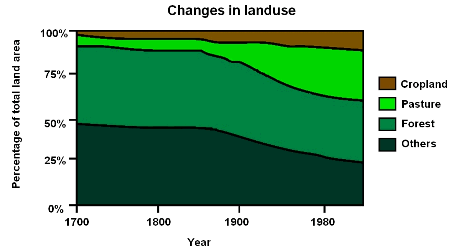1. Global Land Use Change
Land use and land use change (2/2)
Tasks:
1. Observe the land use change from 1700 until today with the help of the diagram. When do the most grave changes occur?
2. Think about which dramatic occurrences and changes could have lead to land use change.
3. Predict a possible future scenario until 2050 and justify your thoughts.
4. Write a newspaper article about the changes in land use. Use either a lurid (a picture magazine) or an academic style.

Data: Goldewijk, Battjes (1997)
In contrast to land cover, which relates to the terrain's physical state, land use is defined as a mode of use of existent resources by humans, like, for example, farming, mining, and felling (Meyer 1995).
Accordingly, land use change is the man-powered change of a land use type either through another form of land use (such as the change from a forest into cultivated land) or through changes in management practices inside of a land use type (for example, the intensification of agriculture). These land use changes are, next to the accompanying fragmentation of habitats (the dissection of living spaces), the most important factors of past and future ecosystem changes (Fischlin et al. 2007).
Forecasted for the future by global studies is a significant decrease in natural vegetation (mostly forests) in non-industrialised countries and arid (dry) regions due to the expansion of agricultural and city-like areas through population growth. The regions with the highest latitudes remain, however, in the future, relatively unchanged (Duraiappah et al. 2005).
Approximately 34% of the global land surface will be agriculturally used, and with that it is clear that agricultural activities are a major cause of land use changes. In the past, approximately 30% of deciduous forests have become cultivated areas and 50% of the grasslands became pastures (Foley et al. 2005, Schinninger 2008).